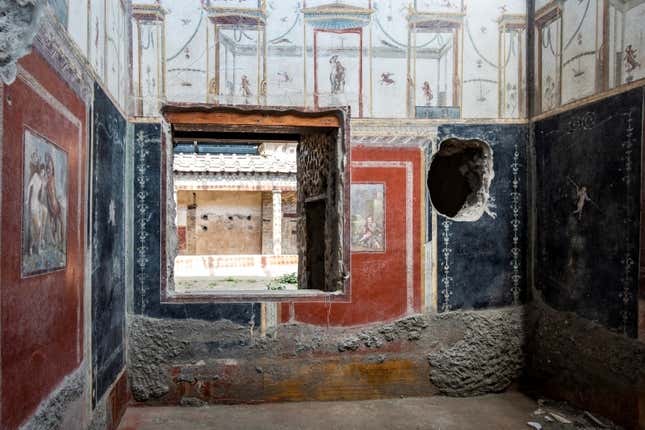Two sets of human remains, a variety of paintings, and a handful of childrens’ doodles were recently found in Pompeii, the ancient Roman town that was buried by a volcanic eruption in 79.
Pompeii was rediscovered in the 18th century and remains an active archaeological site today. Due to the nature of the city’s destruction—it was totally covered in ash spewed up by Mount Vesuvius—the city was remarkably preserved. Two-thousand-year-old bits of food still sit in the city’s outdoor markets, and the grisly circumstances of its residents’ death are frozen in time, their last postures encased in ash.
The team’s report on the new discoveries was published today in the Pompeii Sites’ e-journal. It covers discoveries made in and around several houses at Pompeii. The human remains—of a woman and a man—were found just in front of the House of the Painters at Work. The individuals were “of advanced age,” according to a Pompeii release, and appeared to try to seek refuge from the eruption in a small corridor. Inside the house, archaeologists found frescoes of mythological figures including griffins, mermaids, centaurs, and the gods Venus (Aphrodite), Apollo, and Bacchus (Dionysus).
In the house of the colonnaded Cenacle (Cenacolo colonnato), excavators found charcoal drawings on the walls of one corridor. Based on their rudimentary look, the team concluded they were probably made by a child. The sketches show two gladiators facing off, an eagle’s head, and a hunting scene.

Nearby, the team found more charcoal etchings: the outlines of three small hands, two more gladiatorial scenes, and an apparent boxing scene, with one of the figures lying on the ground. The boxing scene appeared to be done in a red pigment, potentially ochre.
In 2022, archaeologists on the site revealed the interior of a middle class home in the city, complete with amphorae and cookware. The same year, a different team sequenced the genome of a man who died in the eruption, probably due to a pyroclastic flow (a fast-moving, destructive current of hot gas, ash, and volcanic rock that flows down a volcano during an eruption). The new discoveries add to those earlier findings; though Pompeii was buried 1,945 years ago, each new discovery reveals more about the lives of those who lived their, and their fateful final day.
More: Discovery of Partially Mummified Pompeii Resident Reveals a ‘Rags to Riches’ Tale
Trending Products

Cooler Master MasterBox Q300L Micro-ATX Tower with Magnetic Design Dust Filter, Transparent Acrylic Side Panel…

ASUS TUF Gaming GT301 ZAKU II Edition ATX mid-Tower Compact case with Tempered Glass Side Panel, Honeycomb Front Panel…

ASUS TUF Gaming GT501 Mid-Tower Computer Case for up to EATX Motherboards with USB 3.0 Front Panel Cases GT501/GRY/WITH…

be quiet! Pure Base 500DX Black, Mid Tower ATX case, ARGB, 3 pre-installed Pure Wings 2, BGW37, tempered glass window

ASUS ROG Strix Helios GX601 White Edition RGB Mid-Tower Computer Case for ATX/EATX Motherboards with tempered glass…










